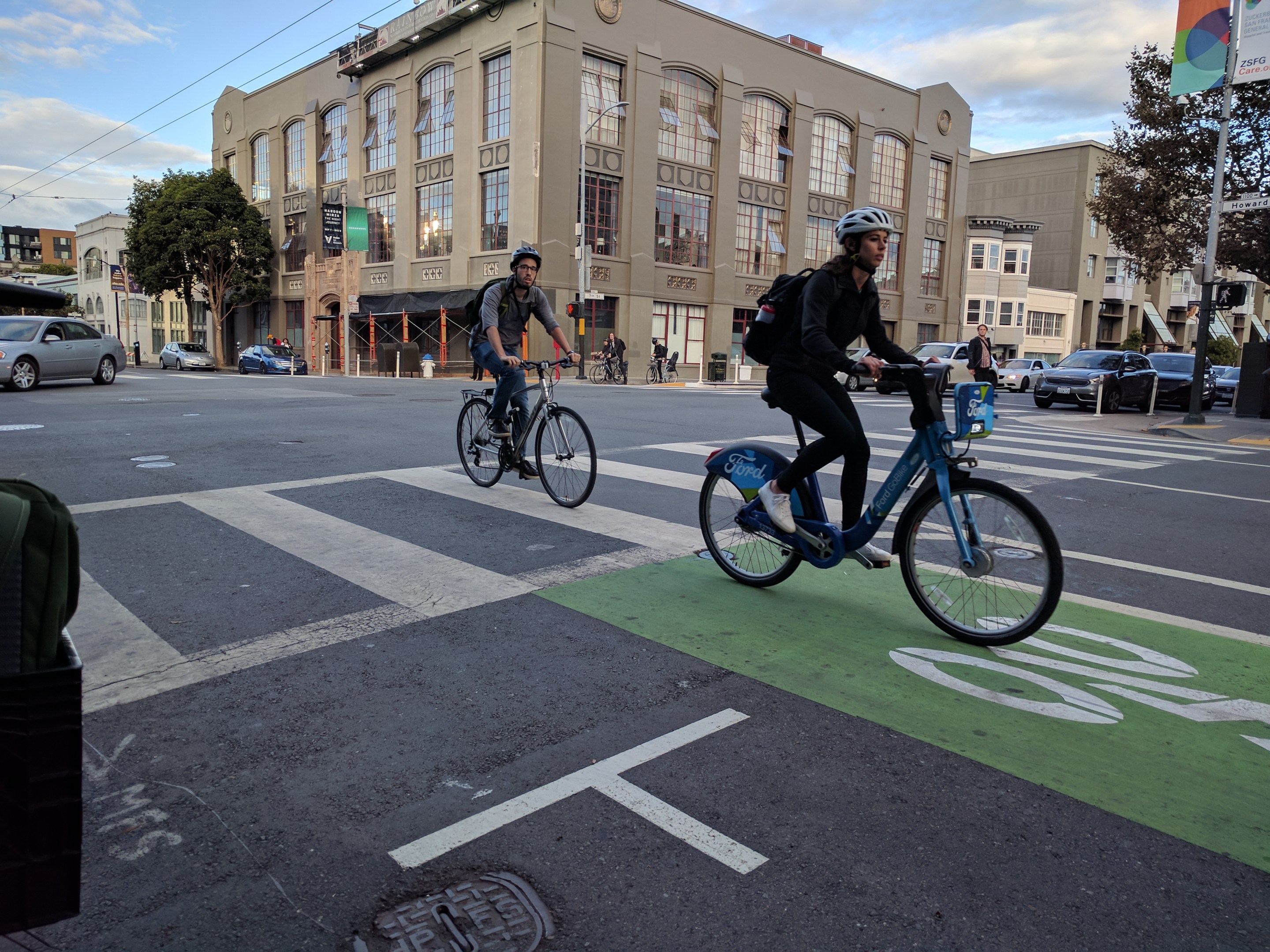One of San Francisco's deadliest streets should get a long-overdue safety upgrade by year's end--according to officials from the SFMTA.
With that in mind, yesterday evening some 10 advocates with the San Francisco Bicycle Coalition took a tour of Howard with Paul Stanis, Project Manager at SFMTA, and Bradley Dunn, who manages communications for Howard Street and other high-injury corridors in the South of Market neighborhood. The ride started at the corner of Harriett Street and Folsom, next to the Gene Friend Recreation Center, at the height of evening rush hour. The idea was to do the survey ride before engineers at SFMTA finalize plans for short-term improvements to the street.
Even before the ride started, several advocates commented at how unsafe it all felt, even standing on the corner of Harriett, a 'calm' side street that connects Folsom and Howard. Motorists were using it as a cut through between Folsom and Howard, and speeding was rampant--at one point a motorist in a Mercedes floored it and must have briefly hit 50 mph going down this narrow street. "I never come down here--it's horrible," remarked Jiro Yamamoto, San Francisco Bicycle Coalition Board Member and a firefighter, of the whole area.
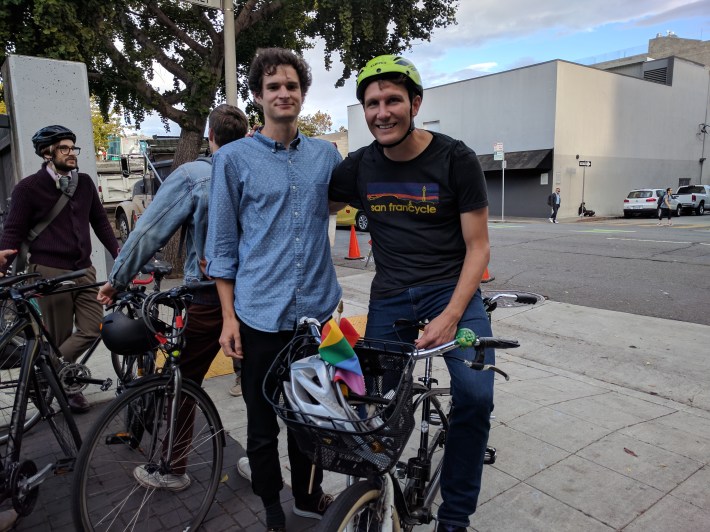
The dangers presented by speeding motorists on the streets of SoMa was particularly acute to the group, given the deaths of Modesto Figuerido, who was killed while crossing Howard at the intersection with 9th on Sept. 18, and Russell Franklin, who was killed the previous Thursday in the crosswalk near Howard and South Van Ness. "Near-term improvements to Howard are crucial and need to happen," said SFBC's Charles Deffarges, who is organizing the advocacy push on streets throughout SoMa. However, he stressed that the long-term project--which would convert many of the wide, high-speed streets of SoMa into calmer, two-way streets, is also essential.
As previously reported, parking-protected bike lanes of varying quality have been installed on Folsom, 8th, 7th, 13th. But Howard, an essential rush hour corridor for cyclists commuting from downtown, was delayed because of fire department concerns over parking protected bike lane placement and the presence of Muni wires (ostensibly these could interfere with the deployment of ladder trucks and access to tall buildings). SFMTA made the tactical decision to move ahead with whatever streets were politically feasible, and come back to Howard later, explained Dunn. "We went in stages, so if we had to wait for Howard, let's get Folsom done."
But now that the fire department impasse is apparently solved, things are moving ahead on Howard too.

But are protected bike lanes enough?
At the survey ride, advocates made it clear they want to see better intersection treatments. "Mixing zones don't cut it anymore," said Deffarges. "We want to see signalization." Some signalization has already gone in at various intersections in SoMa, with bikes getting their own signal to reduce or eliminate potential conflicts with turning motorists.
Indeed, as the group stopped to survey intersections, it was apparent why mixing zones don't work, with lines of motorists muscling in--and often blocking--the mixing zones as they lined up to make right turns. At one point a motorist skipped the queue and turned right from the middle lane, seriously endangering cyclists and pedestrians. "We want to see all intersections signalized," added Deffarges.
"It may seem straightforward to put up a signal with phases [for bikes and cars] separated," said Stanis. "But each signal has a wire and we don't know the condition of the conduit."

Under the street, he explained, are pipes that carry wires to power each signal. Often, those pipes haven't been examined or serviced in decades. Sometimes it's straightforward to thread an additional wire down the pipe to control a bike signal. But other times, due to corrosion, ground movements, etc., the conduit is in such poor shape that it can't carry any more wires. Then the street has to be torn up to fix the situation. "It takes a lot of time and money," said Stanis. The agency is currently investigating which intersections can be upgraded without tearing up the street, and that's how the city is deciding where to add phased signals in the short term. Again, explained Dunn, this is part of a tactic of getting things phased in as soon as possible, rather than trying to fix and upgrade everything at once.
Several of the advocates wanted to know if the SFMTA had looked at any wireless solution, but Stanis said wireless is considered too unreliable for traffic signals. Others wanted to know if they could consider stringing above-ground wiring as a temporary fix. Again, the concern was reliability--and on Howard, with high-voltage trolley-bus wire to cross over, it could also become quite complicated and costly, even as a temporary fix.
Roan Kattouw, one of the advocates on the ride, had a different question about intersections. In 2016, San Francisco installed its first protected intersection at 9th and Division. Kattouw wanted to know if that is going to be the only one San Francisco will ever build--"why not more?" Stanis suggested that protected intersections could be on the table for the long-term project, perhaps at some of the major intersections.
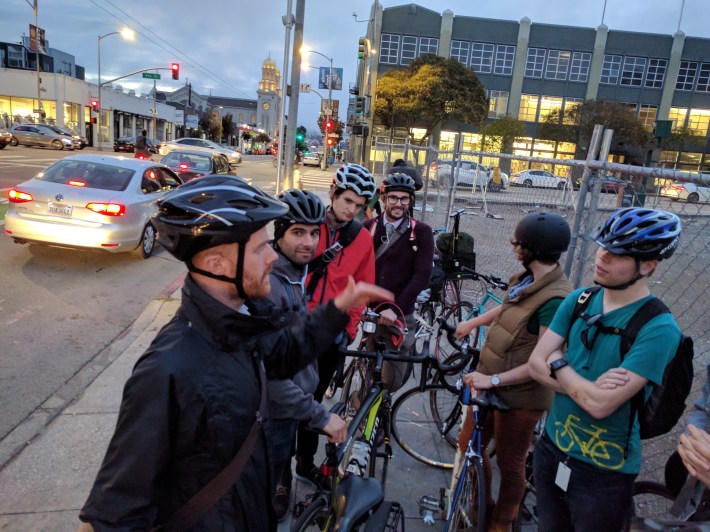
Stanis and Dunn explained that the addition of projected bike lanes has also made it safer for pedestrians by shortening crossing distances--but that is not without challenges. The buffer between the parked cars and the bike lane has to be sufficient to allow wheel chair access between the curb and loading areas. There's also the question of the bus boarding islands and having a level area from the sidewalk, so those in wheel chairs aren't required to go down to street level and then back up to the bus boarding island (an issue Streetsblog has reported on previously, see pic below).
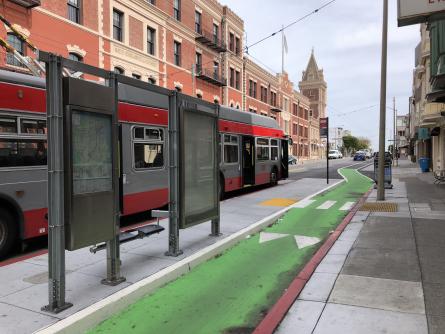
SFMTA is also planning to add more midblock traffic signals, to try and calm traffic and reduce speeding between major intersections. Many of these features will be included in the long-term improvement plans, the next iteration of safety fixes for SoMa, the designs for which should be available this winter.
The group is encouraging people to attend the next SFMTA board meeting on Oct. 16, at 1 p.m., Room 400, 1 Dr. Carlton B. Goodlett Place. The Board will be presented with Howard near-term improvements, and, if approved, crews will finally be able to get to work.
Immediately after Wednesday evening's tour, there was a service and dedication at the location of Franklin's ghost bike (see pic below), one of too many victims of this dangerous street.
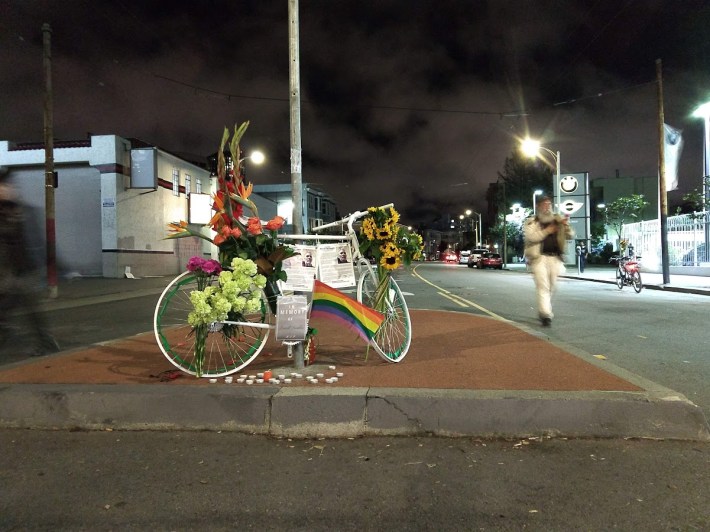
Read More:
Stay in touch
Sign up for our free newsletter
More from Streetsblog San Francisco
Commentary: There is Zero Ambiguity to the West Portal Tragedy
What happened in West Portal was entirely predictable and preventable. The city must now close Ulloa to through traffic and make sure it can never happen again
Independent Safety Advocates Beef up the Wiggle
Signs and soft-hit posts installed by advocates make the Wiggle bike route calmer and safer for cyclists and pedestrians
